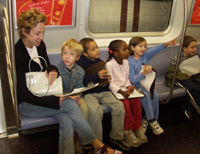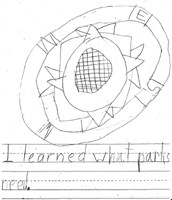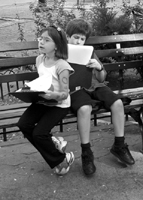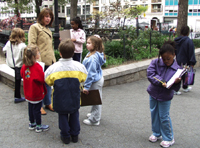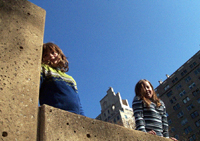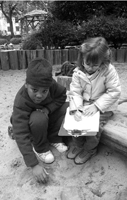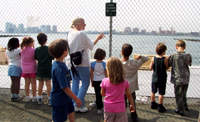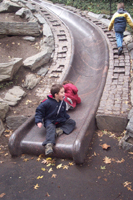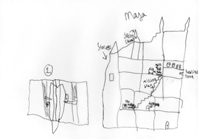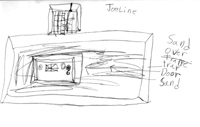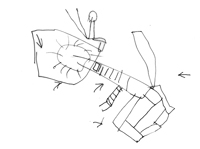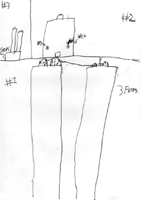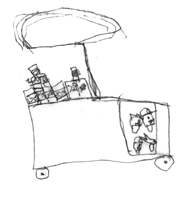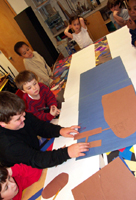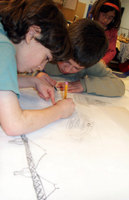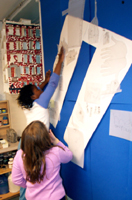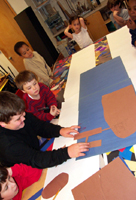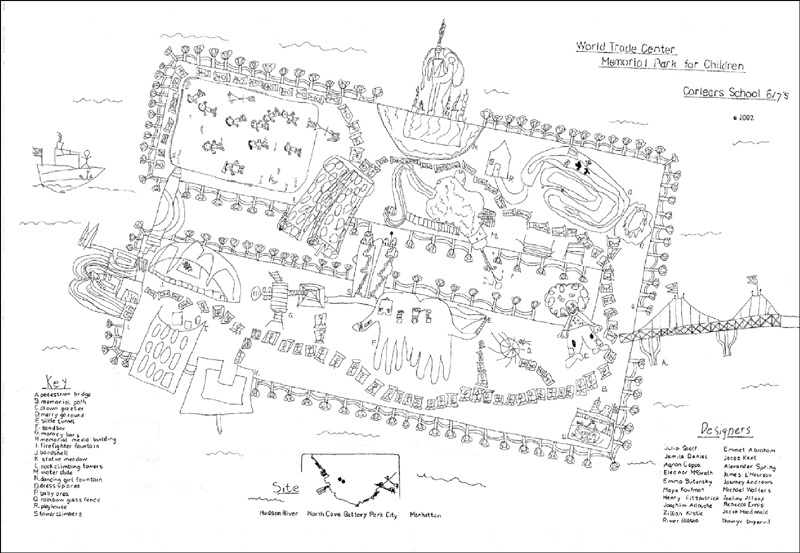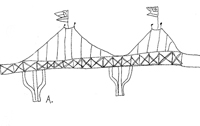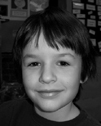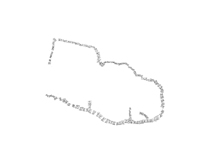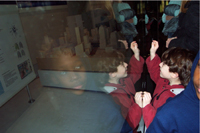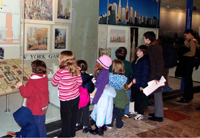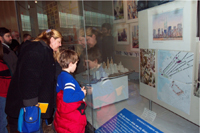The final designs were traced onto the master plan with pencil. The children completed their first draft of the park blueprint in December, two months after the conversation that gave birth to the idea.
A. The World Trade Center Memorial Park for Children is designed to be its own island in the Hudson River. The entrance to the park is a Pedestrian Bridge from the World Financial Center.
B. The Memorial Path will be made of plaques with the names and pictures of every person who died. The path will lead to all the places in the park.
C. The Clown Greeter will meet children at the bridge to make sure they are happy when they enter the park. The Clown is also a secret service person in disguise to keep everyone safe.
D. The Merry-Go-Round is the kind you run around and spins after you jump on. The colors go around in a colorful way. It's good for when you want to get dizzy.
E. The Slide Tunnel goes all the way under the sandbox to the Tower Climbers and Monkey Bars. This is a place where you need to be brave because the tunnel is dark and greased to be really fast.
F. The Sandbox is shaped like two hands that you can step up into and rebuild your favorite places from the town that was inside the World Trade Center. There is a wet and dry sand machine with molds of the facades of the stores. There are signs with the logos of the shops to put on the sand buildings.
G. The Monkey Bars have lots of climbing areas and a Lookout Tower to see the Hudson River and the city.
H. The Memorial Media Building is a place where children can see pictures and hear a radio review of what happened on September 11. There will be DVDs and videos of TV shows about rebuilding progress and how people can have peace together. A TV studio will be set up with chairs in a row for kids to have a talk show about how to have peace in the world. There will be a special room for children who are afraid of terrorists. There will be a special chair to sit and read stories about the people that died. The chair will have a secret button to press when you cry, a robot will come out and wipe your tears.
I. The Firefighter Fountain is a place to remember all the brave people who rescued every one at the World Trade Center. You go up stairs into a tunnel to enter the Firefighter statue without getting wet. The tunnel is dark and at the end are two towers of light that you walk through to get inside the gallery. The gallery will have all the stories about the rescues that happened on September 11th.
J. The Band Shell is there so that there will be music and dancing. Music makes grown-ups relax and dancing make children feel better. This is also a place to have memorial services for children to go to.
K. The Statue Meadow has a statue of every parent that died. The children can run around on the grass and play tag using the statues of their Mommies or Daddies as time-out areas or home base.
L. On the Rock Climbing Towers children can climb up and down the outside of the twin towers. There are chairs on the top where you can rest.
M. The Water Slide is 3 1/2 feet deep. There is a fountain to spray the slide and pool. The Water Slide is a place to just have fun on a hot day.
N. The Dancing Girl Fountain is a relaxing place to be happy. The sound of the water is peaceful.
O. The Dress-Up Area is important because children like to dress-up and pretend. There are hooks with all kinds of costumes and mirrors.
P. The Baby Area is there so babies can have a safe place to be and because holding babies always makes you feel better.
Q. The Rainbow Glass Fence will have colored glass at the top of each post to make rainbows in the park when the sun shines through them. The fence will keep children from falling into the Hudson River. The glass will also hide security cameras to make sure nobody does anything bad.
R. The Playhouse is fun. There is a path from the Dress-Up Area to the Playhouse. Children can go inside after they dress-up and play pretend games.
S. The Tower Climbers have stairs up the center. There are chairs and steering wheels at the top. The only way to get in the towers is through the Tunnel Slide.
T. The Family Building is a place for the children of victims to go. The lobby will have a memory area with a set-up of colored paper and ribbons. The children can write a memory of the person they are missing on the paper and hang it from the ceiling with the ribbon. Inside the building will be many special rooms. There will be a comfortable room with couches and chairs and pictures of all the families. There will be chocolate to eat because chocolate always makes you forget your sadness. The Emotional Room is for children who are upset, there is a real psychiatrist there for them to talk to. There is an E-Mail Chamber where kids can go to send messages to their family that died and the computer will send messages back that will help them feel better. That way kids can still feel like they can talk to the people they miss. There is a Video Room where kids can sit down in front of the camera and tell stories about the people that died. The videos can be shared in the Media Building on a special T.V. channel so all the visitors to the park can hear from the kids about how special each of their parents or grandparents or aunts and uncles were to them.
The Music Room will be a place where children can go to sing songs, not just listen, but really learn the words and sing the songs. Songs like 'We Shall Overcome', 'America the Beautiful', 'Imagine' & Bruce Springsteen songs.
U. The Snack Bar will have hotdogs and lots of treats kids love to eat.

